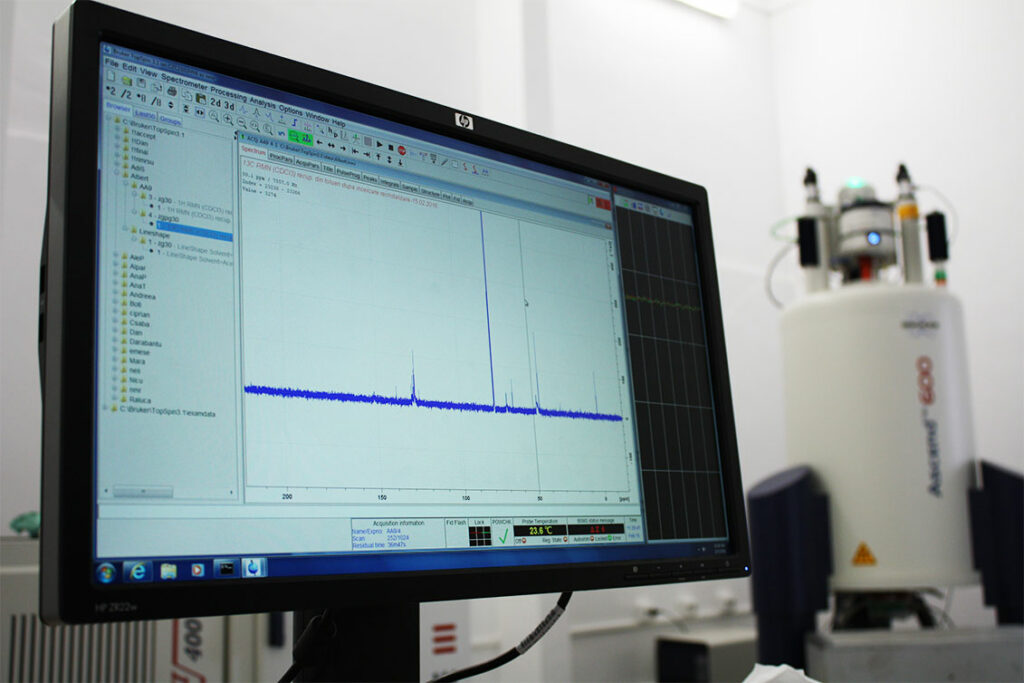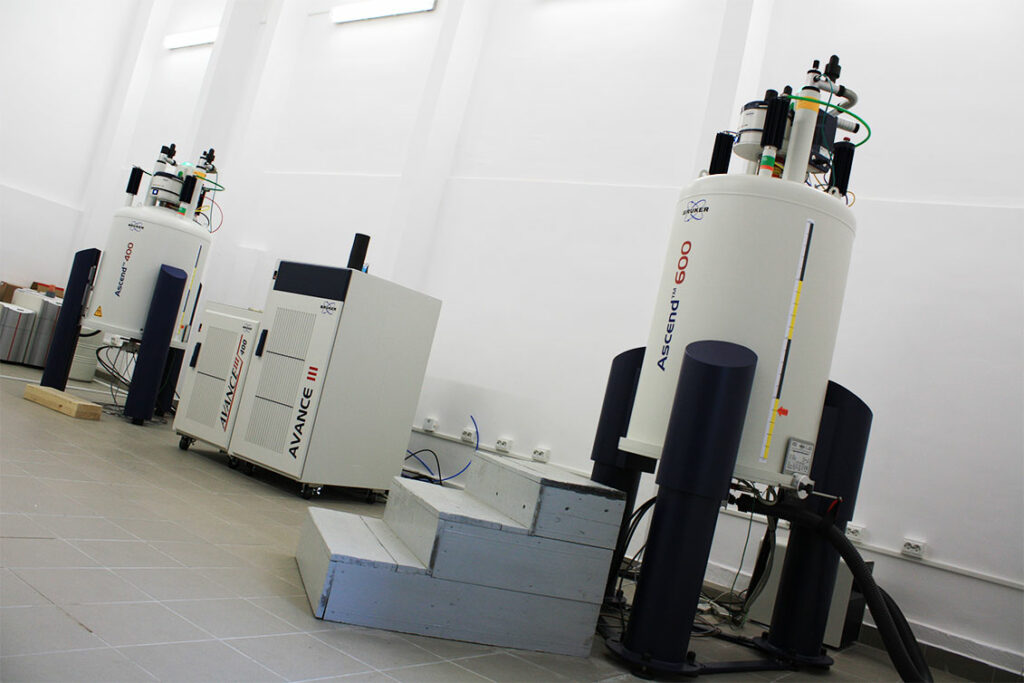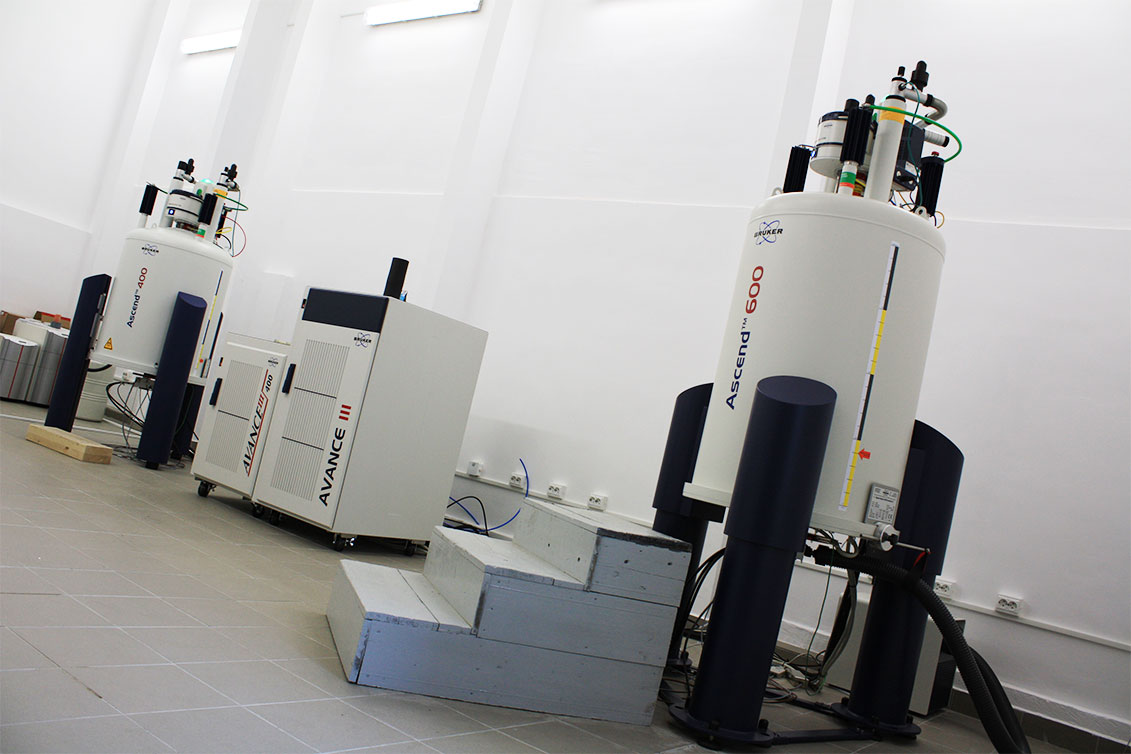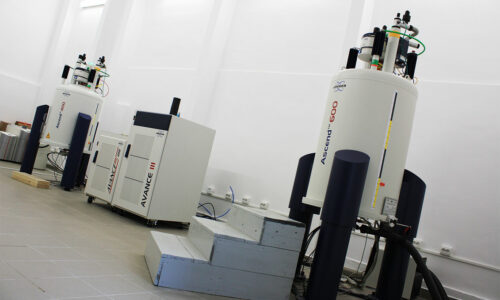The NMR equipment is contained within in the research facilities owned by the Research Centre on Fundamental and Applied Heterochemistry (METALOMICA), which aims the role of heteroatoms in various areas of chemistry: form organic heterocyclic and organometallic synthetic chemistry to the study of inorganic and bio-inorganic systems. The topics of research generally cover synthetic methodology, green chemistry and chemical analysis for the development of novel chemical compounds and materials as well as the exploration of distinctive structure – properties relationships significant in drug design, functional dyes applications and understanding their interactions with biological systems. (http://chem.ubbcluj.ro/~hetorgmet/index.html and http://chem.ubbcluj.ro/~nmr/EN/)
The integrated NMR spectrometry system consists of 2 state-of-the-art NMR spectrometers (Bruker Avance III with ultrashielded magnets Ascend 400 MHz and 600 MHz respectively) purchased with 960.000,00 EUR within the R.I.C.I. project. “Integrated Interdisciplinary Research Network” in 2013.


400 & 600 MHz Spectrometer:
- 400MHz ultra-shielded superconducting magnet
- Automatic measurement of N2L and HeL cryogenic fluid levels; low coolant level alarm
- Vibration dampers
- Two equivalent, interchangeable channels, generating frequencies in the 6-430 MHz range
- Z-axis field gradients and control module with 10A amplifier
- Module for experiments at variable temperature (high, respectively low temperature; temperature range -60oC +80oC)
- Automatic sample changer
- Possible experiments: 1D- NMR (1H, 13C, 19F, 29Si, 31P, 77Se, 97Mo, 109Ag, 113Cd, 119Sn, 125Te, 199Hg), 2-D NMR (COSY, HMBC, HMQC, HSQC, NOESY, ROESY)
- 2 probe heads (5 mm): PA BBO 400 MHz S1; PA BBI 400 MHz S1
- 600 MHz Spectrometer:
- 600MHz ultra-shielded superconducting magnet
- Automatic measurement of N2L and HeL cryogenic fluid levels; low coolant level alarm
- Vibration dampers
- Two equivalent, interchangeable channels, generating frequencies in the 6-640 MHz range
- Z-axis field gradients and control module with 10A amplifier
- Module for experiments at variable temperature (high, respectively low temperature; temperature range -60oC +80oC)
- Automatic sample changer
- Possible experiments: 1D- NMR (1H, 13C, 19F, 29Si, 31P, 77Se, 97Mo, 109Ag, 113Cd, 119Sn, 125Te, 199Hg), 2-D NMR (COSY, HMBC, HMQC, HSQC, NOESY, ROESY)
- 3 probe heads (5 mm): PA BBO 600 MHz S3; PH BBI 600 MHz S3; PA TXI 600 MHz S3
- 400MHz ultra-shielded superconducting magnet
The NMR infrastructure is absolutely necessary for the structural validation of synthesized or natural compounds, both in research activities and in the case of teaching activities.
The fields of applicability are not limited only to the characterization of synthetic organic or organometallic compounds (new compounds in the case of research activities, or compounds obtained by repeating some syntheses in the case of didactic activities), the NMR infrastructure being decisive also in the case of the characterization of natural products and in the confirmation structure of new products resulting in biochemical syntheses.
In the last 2 years the NMR system was used in order to publish 59 articles in international ISI journals.
Last but not the least, the NMR system is used for students teaching activities.
Access policy and costs
BBU community members
Free – based on partnership agreement
All other universities
Free – based on partnership agreement… other particular conditions may apply. In absence of this agreement, Industry category rates are applicable.
Industry
Standard 1H Analysis: 50 EUR * (No analysis/interpretation of data/assuming sample not limited (>2 mg))
Standard 13C Analysis of Small Molecule: 200 EUR * (No analysis/interpretation of data/assuming sample is not limited (>300 mg))
Quantitative 13C NMR: 300-450 EUR * (High S/N acquired – Typically Overnight Analysis)
2D À la carte (2D COSY, 2D HSQC &2D HMBC): COSY 200 EUR, HSQC 350 EUR, HMBC 450 EUR.
2D Package (1D Proton, 2D COSY, 2D HSQC & 2D HMBC) 650 EUR
* Includes NMR Tube and Standard Deuterated Solvents. Includes spectrometer set up and routine sample prep. Normal Turnaround: 3-7 business days
Contact person
Dr. Dan PORUMB
http://chem.ubbcluj.ro/~nmr/EN/
Research and publications
NMR spectrometers are absolutely necessary both for research activities within the Faculty of Chemistry and Chemical Engineering as well as for didactic activities (routine structural determinations of compounds synthesized in didactic laboratories, demonstrative experiments with students with measurements performed on various nuclei, mono- and two-dimensional, etc.). The PhD students, but not only them, have the opportunity to make the structural determinations on the newly synthesized compounds in order to be able, by interpreting the corresponding spectra, to find out if that synthesized compound is the desired one (whether it is a final synthesis product or a reaction intermediate) and to make a documented decision about the evolution of the synthesis procedures developed during the doctoral internship and/or the research stage.
In the last 2 years the NMR system was used in order to publish 59 articles in international ISI journals.
- Ultrasound-assisted Strecker synthesis of novel 2-(hetero) aryl-2-(arylamino) acetonitrile derivatives, E. Gal, L. Gaina, H. Petkes, A. Pop, C. Cristea, G. Barta, D. C. Vodnar, L. Silaghi-Dumitrescu, Beilstein Journal of Organic Chemistry, 2020, 16(1), 2929-2936, doi.org/10.3762/bjoc.16.242
- 2. Novel (Phenothiazinyl)Vinyl-Pyridinium Dyes and Their Potential Applications as Cellular Staining Agents, B. Stoean, D. Rugina, M. Focsan, A.-M. Craciun, M. Nistor,T. Lovasz, A. Turza, I.-D. Porumb, E. Gál, C. Cristea, L. Silaghi-Dumitrescu, S. Astilean, L. I. Gaina, Int. J. Mol. Sci. 2021, 22(6), 2985, doi: 10.3390/ijms22062985
- 3. Optical properties modulation of cyanine dyes in organic solvents and in the critical intracellular pH window, R. Sisa, B. Brém, E. Gál, L. Gaina, D. Porumb, C. Cristea, L. Silaghi-Dumitrescu, STUDIA UBB CHEMIA, LXIV, 2, Tom II, 2019 (p. 547-553), DOI:10.24193/subbchem.2019.2.47
- 4. New β-ketophosphonates for the synthesis of prostaglandin analogues. 3. Phosphonates with pentalenofurane scaffolds linked to the ketone group; X-ray crystallography, C. I. Tanase, C. Draghici, M. T. Caproiou, A. Hanganu, G. Borodi, M. Maganu, E. Gal, L. Pintilie, Int. J. Mol. Sci. 2021, 22, 6787, doi.org/10.3390/ijms22136787
- 5. New fluorescent phenothiazine carboxylates for fluorescent nanomaterials, Melinda Gal, Castelia Cristea, Tamas Lovasz, Ana-Maria Craciun, Alexandru Turza, Dan Porumb, Emese Gal, Gabriel Katona, Luminita Silaghi-Dumitrescu, Luiza Gaina, Journal of Molecular Structure, 2021, 1246, 2021, 131174, doi.org/10.1016/j.molstruc.2021.131174
- 6. Optical properties of new 5-(phenothiazinyl)methylidenebarbituric acid derivatives, Emese Gal, Balazs Brem, Luiza Ioana Gaina, Anamaria Gabudean, Castelia Cristea, Luminita Silaghi-Dumitrescu, Journal of Molecular Structure, 2022, 1247,131334, doi.org/10.1016/j.molstruc.2021.131334
- 7. Photophysical Properties and Electronic Structure of Symmetrical Curcumin Analogues and Their BF2 Complexes, Including a Phenothiazine Substituted Derivative, E. Gal, L. Cs. Nagy, Symmetry 2021, 13(12), 2299; https://doi.org/10.3390/sym13122299
- 8. Diastereoselective synthesis of (8e,10z)-tetradeca-8,10-dienal, the sexual pheromone of the horse-chestnut leaf-miner Cameraria ohridella (lepidoptera: gracillariidae), I. Vasian, T. Florian, A. Nan, E. Gal, M. Gorgan, S.M. Totos, V. Florian, I. Oltean, STUDIA UBB CHEMIA, LXVI, 4, 2021 (p. 205-224), DOI:10.24193/subbchem.2021.4.15
- 9. Hypercoordinated organotin(IV) compounds containing (imino)aryl ligands – [(E)-2-(2′,6′-iPr2C6H3N=CH)C6H4]SnR2X (R = Me; X = Cl, I; R = nBu, X = Cl, F, Br). Molecular structures and supramolecular aspects, C. Comsa, R. A. Varga, A. Soran, C. Silvestru, Rev. Roum. Chim., 2020, 65(6), 539-552. DOI: 10.33224/rrch.2020.65.6.03
- 10. Synthesis and characterization of novel homobimetallic organotin(IV) compounds A.-A. Someșan, I. Barbul, S.-M. Vieriu, R. A. Varga, Rev. Roum. Chim., 2020, 65(7-8), 725-733. DOI: 10.33224/rrch.2020.65.7-8.11
- 11. Synthesis, structural characterization and in vitro antiproliferative effects of novel organotin(IV) compounds with nicotinate and isonicotinate moieties on carcinoma cells S.-M. Vieriu, A.-A. Someșan, C. Silvestru, E. Licarete, M. Baciu, R. A. Varga, New J. Chem., 2021, 45, 1020-1028. DOI: 10.1039/d0nj05069e
- 12. Reactivity of a carbonyl moiety in organotin(IV) compounds. Novel Pd(II) and Cu(II) complexes supported by organotin(IV) ligands A.-A. Someșan, C. Silvestru, R. A. Varga, New J. Chem., 2021, 45, 3817-3827. DOI: 10.1039/D0NJ06016J
- 13. C,O-Chelated organotin(IV) derivatives as potential anticancer agents: Synthesis, characterization, and cytotoxic activity A.-A. Someșan, S.-M. Vieriu, A. Crăciun, C. Silvestru, P. Chiroi, A. Nutu, A. Jurj, R. Lajos, I. Berindan-Neagoe, R. A. Varga, Appl. Organomet. Chem., 2022, 36, e6540. DOI: 10.1002/aoc.6540
- 14. Supramolecular architectures in novel diphenyl(aryl)tin(IV) chlorides C. Afloarei, I. Barbul, A.-A. Someșan, C. Silvestru, R. A. Varga, Polyhedron, 2022, 222, 115894. DOI: 10.1016/j.poly.2022.115894
- 15. The modulation of 9-Chloro-9-Phosphaalkenylchloro-9-Germafluorene reactivity through organolithium reagents, Lavinia Buta, Raluca Septelean*, Albert Soran, Iulia-Andreea Aghion, Ionut-Tudor Moraru, Gabriela Nemes, Polyhedron, 2021, vol 210, available online DOI 10.1016/j.poly.2021.115505
- 16. Novel coordination compounds featuring 9-chloro-9-phosphaalkenylchloro-9-germafluorene ligands, Noemi Deak, Raluca Septelean, Lavinia Buta, Ionut-Tudor Moraru, Iulia-Andreea Cretoiu, Albert Soran, Gabriela Nemes, Polyhedron, 2022, vol 221, available online DOI 10.1016/j.poly.2022.115866
- 17. Bartha-Vári J.-H., Moisă M. E., Bencze L. C., Irimie F.-D., Paizs C., Toşa M. I., Efficient biodiesel production catalyzed by nanobioconjugate of lipase from Pseudomonas fluorescens, Molecules (2020) 25(3): 651, DOI: 10.3390/molecules25030651.
- 18. Lǎcǎtuş M. A., Dudu A. I., Bencze L. C., Katona G., Irimie F.-D., Paizs C., Toşa M. I., Solvent-Free Biocatalytic Synthesis of 2,5-bis-(Hydroxymethyl)Furan Fatty Acid Diesters from Renewable Resources, ACS Sustainable Chemistry and Engineering (2020) 8(3): 1611-1617, DOI:10.1021/acssuschemeng.9b06442.
- 19. Moisǎ M. E., Amariei D. A., Nagy E. Z. A., Szarvas N., Toşa M. I., Paizs C., Bencze L. C. Fluorescent enzyme‑coupled activity assay for phenylalanine ammonia‑lyases, Scientific Reports (2020) 10: 18418-18428, DOI: 10.1038/s41598-020-75474-y.
- 20. Spelmezan C. G., Bencze L. C., Katona G., Irimie F. D., Paizs C., Toșa M. I., Effcient and stable magnetic chitosan-lipase B from candida antarctica bioconjugates in the enzymatic kinetic resolution of racemic heteroarylethanols, Molecules (2020) 25(2): 350, DOI: 10.3390/molecules25020350. – aparatul RMN nu apare menționat explicit în publicație dar structura substraturilor sintetizate conform metodelor publicate anterior a fost confirmată prin spectroscopie 1H- și 13C-RMN.
- 21. Matei A., Pușcaș C., Pătrașcu I., Lehene M., Ziebro J., Scurtu F., Baia M., Porumb D., Tőtős R., Silaghi-Dumitrescu R., Stability of Glutaraldehyde in Biocide Compositions, International Journal of Molecular Sciences (2020) 21(9): 3372, DOI: 10.3390/ijms21093372.
- 22. Dudu A. I., Lacatus M. A., Bencze L. C., Paizs C., Tosa M. I., Green Process for the Enzymatic Synthesis of Aroma Compounds Mediated by Lipases Entrapped in Tailored Sol-Gel Matrices, ACS Sustainable Chemistry and Engineering (2021) 9(15): 5461-5469, DOI: 10.1021/acssuschemeng.1c00965.
- 23. Gal C. A., Barabás L. E., Bartha-Vári J.-H., Moisă M. E., Balogh-Weiser D., Bencze L. C., Poppe L., Paizs C., Toșa M. I., Lipase on carbon nanotubes – an active, selective, stable and easy-to-optimize nanobiocatalyst for kinetic resolutions, Reaction Chemistry & Engineering (2021) 6: 2391-2399, DOI: 10.1039/D1RE00342A.
- 24. Varga A., Csuka P., Sonesouphap O., Bánóczi G., Toşa M. I., Katona G., Molnár Z., Bencze L. C., Poppe L., Paizs Csaba, A novel phenylalanine ammonia-lyase from Pseudozyma antarctica for stereoselective biotransformations of unnatural amino acids, Catalysis Today, (2021), 366: 185–194, DOI: 10.1016/j.cattod.2020.04.002 – aparatul RMN nu apare menționat explicit în publicație dar structura substraturilor sintetizate conform metodelor publicate anterior a fost confirmată prin spectroscopie 1H- și 13C-RMN.
- 25. Scrob D. M., Lăcătuș M. A., Dudu A. I., Eco-friendly enzymatic synthesis of anisyl propionate mediated by lipase b from Candida antarctica, Studia Universitatis Babeș-Bolyai Chemia (2021) 66(2): 277–286, DOI: 10.24193/subbchem.2021.2.24.
- 26. Duță H., Filip A., Nagy L. C., Nagy E. Z. A., Tőtős R., Bencze L. C., Toolbox for the structure-guided evolution of ferulic acid decarboxylase (FDC), Scientific Reports (2022) 12(1): 3347, DOI: 10.1038/s41598-022-07110-w.
- 27. Gal C. A., Barabás L.-E., Varga A., Csuka P., Bencze L. C., Toșa M. I., Poppe L., Paizs C., How to identify and characterize novel transaminases? Two novel transaminases with opposite enantioselectivity for the synthesis of optically active amines, Molecular Catalysis (2022), 531: 112660, DOI: 10.1016/j.mcat.2022.112660.
- 28. Sonogashira Synthesis of New Porous Aromatic Framework-Entrapped Palladium Nanoparticles as Heterogeneous Catalysts for Suzuki–Miyaura Cross-Coupling L. Căta, N. Terenti, C. Cociug, N. D. Hădade, I. Grosu, C. Bucur, B. Cojocaru, V. I. Parvulescu, M. Mazur, J. Čejka ACS Appl. Mater. Interfaces 2022, 14, 10428–10437, DOI: 10.1021/acsami.1c24429.
- 29. Macrocyclic Compounds Formed in the Reaction of 3,7-Bis(ortho-, oeta- or para-formylphenyl) phenothiazines with meta-Bis(Aminomethyl)benzene: experimental and Theoretical Investigations I, Stroia, M. Irina Nan, E. Bogdan, A. Terec, N. D. Hădade, I. Grosu Rev. Roum. Chim, 2022, 67, 141-149.
- 30. Structure-properties of small donor-acceptor molecules for homojunction single-material organic solar cells N. Terenti, G. -I. Giurgi, C. Anghel, A. Bogdan, A. Pop, I. Stroia, A. Terec, L. Szolga, I. Grosu, J. Roncali, J. Mater. Chem. C 2022, 10, 5716-5726.
- 31. Effect of the Terminal Acceptor Unit on the Performance of Non-Fullerene Indacenodithiophene Acceptors in Organic Solar Cells N. Terenti, G.-I. Giurgi, L. Szolga, I. Stroia, A. Terec, I. Grosu, A. P. Crișan, Molecules 2022, 27, 1229.
- 32. Effect of the mode of fixation of the thienyl rings on the electronic properties of electron acceptors based on indacenodithiophene (IDT). N. Terenti, A. P. Crisan, S. Jungsuttiwong, N. D. Hădade, A. Pop, I. Grosu, J. Roncali, Dyes Pigm. 2021, 109116, DOI:10.1016/j.dyepig.2020.109116.
- 33. An attempt to synthesize a terthienyl-based analog of indacenedithiophene (IDT): unexpected synthesis of a naphtho[2,3-b]thiophene derivative. C. C. Anghel, I. Stroia, A. Pop, A. Bende, I. Grosu, N. D. Hădade, J. Roncali, RSC Adv. 2021, 11, 9894–9900, DOI: 10.1039/D1RA00659B.
- 34. Structure-properties relationships in triarylamine-based push-pull systems-C60 dyads as active material for single-material organic solar cells A. Bogdan, L. Szolga, G,-I. Giurgi, A. P. Crişan, D. Bogdan, S. Hadsade, S. Jungsuttiwong, R. Po, I. Grosu, J. Roncali Dyes Pigm., 2021, 184, 108845.
- 35. Halogen Bonds (N—I) at Work: Supramolecular Catemeric Architectures of 2,7-Dipyridylfluorene with ortho-, meta- or para-Diiodotetrafluorobenzene Isomers. I. G. Grosu, L. Pop, M. Miclǎuş, N. D. Hǎdade, A. Terec, A. Bende, C. Socaci, M. Barboiu, I. Grosu, Cryst. Growth Des. 2020, 20, 3429–3441, DOI:10.1021/acs.cgd.0c00205.
- 36. Click Synthesis and Complexation Properties of a New Unsymmetrical Macrocycle Bearing 1,4-Dioxabenzene and Triazole Units. T. A. Cucuiet, C. C. Anghel, E. Bogdan, A. Crişan, M. Matache, L. Pop, A. Terec, N. D. Hădade, Rev. Roum. Chim., 2020, 65, 567-572, DOI: 10.33224/rrch.2020.65.6.06.
- 37. Selective Hydration of Electron-Rich Aryl-Alkynes by a Schrock-Type Molybdenum Alkylidene Catalyst. A. Crişan, A. Pop, E. Bogdan, M. Matache, L. Pop, A. Terec, I Grosu, N. Hădade, Rev. Roum. Chim. 2020, 65, 699–705, DOI: 10.33224/rrch.2020.65.7-8.07.
- 38. Mono- and di-substituted pyrene-based donor-pi-acceptor systems with phenyl and thienyl pi-conjugating bridges M. I. Nan, E. Lakatos, G.-I. Giurgi, L. Szolga, R. Po, A. Terec, S. Jungsuttiwong, I. Grosu, J. Roncali, Dyes Pigm. 2020, 181, 108527.
- 39. Synthesis, Structure and Supramolecular Properties of a Novel C3 Cryptand with Pyridine Units in the Bridges C. V. Crișan, A. Soran, A. Bende, N. D. Hădade, A. Terec, I. Grosu, Molecules 2020, 25, 3789.
- 40. A straightforward synthesis of novel 1,3,5-triazine-based macrocyclic scaffolds C. V. Crișan, N. D. Hădade, I. Grosu, A. P. Crișan, A. Terec, Stud. Univ. “Babeş-Bolyai”, Chem. 2020, 65, 171-179.
- 41. 118. Cu(II) and Ag(I) complexes of the pyrazole-derived diorganoselenide (pzCH2CH2)2Se. Synthesis, solid state structure and solution behavior. R. A. Popa, V. Lippolis, A. Silvestru Inorg. Chim. Acta, 2021, 520, 120272, doi.org/10.1016/j.ica.2021.120272.
- 42. New hypercoordinated triaryltelluronium derivatives of organophosphorus ligands. Synthesis and structural characterization. E. Denes, M. Vlassa, C. Silvestru, A. Silvestru, Rev. Roum. Chim., 2021, 66 (1), 33-40. DOI: 10.33224/rrch.2021.66.1.03
- 43. {2,6-bis[(dimethylamino)methyl]phenyl}mercury(II) acetate, [2,6-(Me2NCH2)2C6H3]Hg(OAc) – a useful intermediate for selective palladation of 1,3-(Me2NCH2)2C6H4. L. Kiss, S. Shova, M. Vlassa, A. Silvestru, C. I. Raţ, C. Silvestru Rev. Roum. Chim., 2021, 66 (2), 167-177. DOI: 10.33224/rrch.2021.66.2.07.
- 44. Structural aspects in diorganotin(IV) complexes. Ph2Sn(S2CNMe2)(NCS) case study. C. Șalgău, C. Silvestru, A. Silvestru, Rev. Roum. Chim., 2021, 66 (3), 231-237. DOI: 10.33224/rrch.2021.66.3.02.
- 45. Silver(I) complexes based on diorganoselenium(II) ligands with amino or hydroxo functionalities. M. David, R. Mitea, A. Silvestru, J. Mol. Struct., 2021, 1246, 131243. DOI: 10.1016/j.molstruc.2021.131243.
- 46. New mercury(II) complexes of polydentate ligands, C. Șalgău, A. Dobri, A. Silvestru, Studia Univ. “Babes-Bolyai”, Chemia, LXVI, 2021, 3, 175-185. DOI: 10.24193/subbchem.2021.3.10
- 47. Coordination behavior of PPh2{C6H4[CH2N(CH2CH2)2O]-2}. Case study CdCl2[PPh2{C6H4[CH2N(CH2CH2)2O]-2}] Ancuța Covaci, Cristian Silvestru, Anca Silvestru, Main Group Metal Chemistry, 2021, 44, 261-266. doi.org/10.1515/mgmc-2021-0029.
- 48. Group 12 metal complexes of mixed thia/aza and thia/oxa/aza macrocyclic ligands. A. M. Hodorogea, A. Silvestru, V. Lippolis, A. Pop Polyhedron, 2022, 216, 115650. doi.org/10.1016/j.poly.2022.115650
- 49. New ionic [{2-(Me2NCH2)C6H4}(R)Sn{(EPPh2)2N}][(EPPh2)2N] (R = 2-(Me2NCH2)C6H4, nBu; E = O, S, Se) compounds. Solution behavior and solid state structure. E. Denes, L. Marongiu, M. Arca, V. Lippolis, A. Silvestru J. Organomet. Chem., 963, 2022, 122282, doi.org/10.1016/j.jorganchem.2022.122282.
- 50. Silver(I) and gold(I) complexes of multidentate ligands based on functionalized pyridine. D. Dumitraș, A. Pop, A. Silvestru, Polyhedron, 2022, 220, 115801. https://doi.org/10.1016/j.poly.2022.115801
- 51. Homoleptic and heteroleptic diorganoselenides containing pyrazole functionalities. Synthesis, characterization, and antioxidant activity. R. A. Popa, A. Nicoară, M. Arca, V. Lippolis, A. Pintus, A. Silvestru, Appl. Organomet. Chem., 2022, e6894. https://doi.org/10.1002/aoc.6894
- 52. Halogen bonding between entirely negative fluorine atoms? Evidence from the crystal packing of some gold(i) and gold(iii) complexes with extensively fluorinated m-terphenyl ligands and triphenylphosphane, A. Sava, K. T. Kegyes, B. T. Popuş, B. C. Dan, C. Silvestru, C. I. Raţ, CrystEngComm 2020, 22, 8285–8289.
- 53. Hypercoordinated diorganoantimony(III) compounds of types [2-(Me2NCH2)C6H4]2SbL and [PhCH2N(CH2C6H4)2]SbL (L = Cl, ONO2, OSO2CF3). Synthesis, structure and catalytic behaviour in the Henry reaction, R. Şuteu, C. I. Raţ, C. Silvestru, A. Simion, N. Candu, V. I. Pârvulescu, A. Silvestru, Appl. Organomet. Chem. 2020, 34, e5393.
- 54. Synthesis and characterization of [4-{(CH2O)2CH}C6H4]2Hg, [4-(O=CH)C6H4]2Hg and [(E)-4-(RN=CH)C6H4]2Hg (R = 2′-py, 4′-py, 2′-pyCH2, 4′-pyCH2), L. Kiss, A. Pop, S. Shova, C. I. Raț, C. Silvestru, Appl. Organomet. Chem. 2021, 35, e6339.
- 55. Hypercoordinated triorganotellurium(IV) derivatives of chalcogen-centred organophosphorus ligandsE. Denes, A. Beleagă, A. Silvestru, Inorg. Chim. Acta 2020, 511, 119841.
- 56. Hypercoordinated diorganopnicogen(III) compounds based on a butterfly-like skeleton of type [CH3OCH2CH2N(CH2C6H4)2]M (M = Sb, Bi) Răzvan Şuteu, A. M. Toma, M. Mehring, A. Silvestru, J. Organomet. Chem. 2020, 920, 121343.
- 57. Synthesis, structural characterization and in vitro antiproliferative effects of novel organotin(iv) compounds with nicotinate and isonicotinate moieties on carcinoma cells, S.-M. Vieriu, A.-A. Someşan, C. Silvestru, E. Licarete, M. Banciu, R. A. Varga, New J. Chem. 2021, 45, 1020–1028.
- 58. Reactivity of a carbonyl moiety in organotin(iv) compounds: novel Pd(ii) and Cu(ii) complexes supported by organotin(iv) ligands, A.-A. Someşan, C. Silvestru, R. A. Varga, New J. Chem. 2021, 45, 3817–3827.
- 59. Tetra-(p-tolyl)antimony(III)-containing heteropolytungstates, [{(p-tolyl)SbIII}4(A-α-XW9O34)2]n− (X = P, As, or Ge): Synthesis, structure, and study of antibacterial and antitumor Activity, T. Ma, P. Yang, I. Dammann, Z. Lin, A. S. Mougharbel, M.-X. Li, F. Adǎscǎliţei, R. Mitea, C. Silvestru, C. Thorstenson, M. S. Ullrich, K. Cseh, M. A. Jakupec, B. K. Keppler, M. Donalisio, R. Cavalli, D. Lembo, U. Kortz, Inorg. Chem. 2020, 59, 2978–2987.


